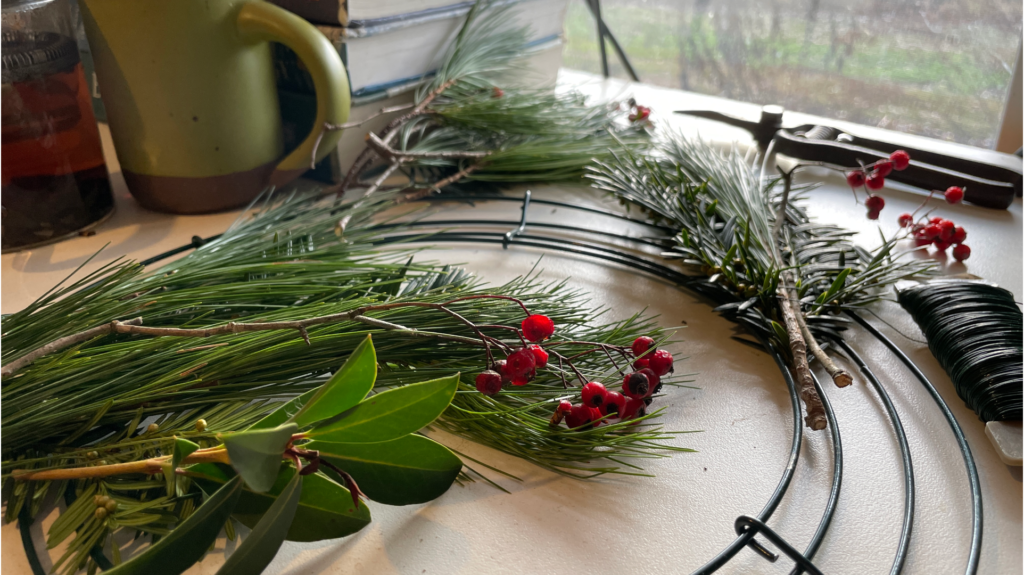Gardening Tasks To Do in December
Cold days and long nights mark early winter. Most plants and animals are resting or dormant. And so are many gardeners. 😉 Our early winter checklist is intentionally short as this is the perfect time of year to pause, reflect, and rest.
Who Is This For?
Our recommendations are for gardeners interested in growing healthy food and healthy ecosystems. We use organic methods, get the whole family involved, and work with nature using ideas from ecology and permaculture.
Early winter falls in December for us – we live in the Northern Hemisphere in USDA Zone 7. These recommendations can be adapted to many gardens in Zone 6-8. (Not sure what your zone is? Find your USDA zone here. Not in the U.S.? This pdf comparing international zone systems may help.)
Quick 3 for Busy Gardeners
If you have limited time for gardening, I recommend you focus on these three areas this month:
- Write about last season in retrospect.
One of the best ways to improve your garden is to reflect on the past. Winter is the perfect time to think about what worked, what didn’t, and what opportunities you’d like to explore. We do a simple 3-step exercise called “Roses & Thorns.” Download a printable to try it out. - Bring nature inside with homegrown food and decorations.
From preserves to low-tunnel greens and dried herbs to fresh evergreens, it’s delightful to create with natural materials for your mid-winter celebrations. If you don’t have your own foods or materials to use, seek out local sources at the farmers’ market or food co-op. - Observe your yard’s “bones.”
Take a closer look at the garden which might seem dreary at first. And take notes. You’ll find interesting patterns, colorful stems, and remnants telling stories from the season past. Check for warm micro-climates in protected sunward areas and frost pockets in lower areas where cold settles. How do winter rains move across your landscape and which way do the winds blow?
Plants
- Continue enjoying greens from tunnels and greenhouses.
Harvest any leaves that touch the plastic/glass as these will probably be damaged by freezes soon. - Plant any remaining bulbs.
If your soil hasn’t frozen, you can still plant garlic, shallots, and spring-blooming bulbs. You might even get a great price for the remnants of fall sales at your garden center. - Harvest conifers for Christmas trees, wreaths, and garlands.
If you wait to harvest after you’ve had 3 nights below freezing, needles will stay on branches longer. Remember to make a fresh cut on the end of your tree or greens going into a decorative pot for your porch. This allows the cutting to continue taking up water so it stays fresh longer. - Learn how to make a wreath with the on-demand wreath workshop in our Premium Membership.

- Forage for other winter decorations.
Prune from shrubs with interesting stems, collect invasive vines (like ivy and bittersweet), pick up pine cones, and gather cool seed pods to bring nature inside this season. - Continue to water if needed.
You may not need to water this month unless it’s unusually dry or warm. - Experiment with winter sowing.
You can plant seeds that require cold stratification in the soil or in protected containers this month. Learn more about winter sowing.
Soil
- Compost through winter.
A large bin will often stay warm enough in the center for decomposition to continue in the winter. If needed, keep some dry brown material in a protected area, so you can get it even if there’s snow on the ground. And be sure to cover the bin to keep cold melt water from running through the middle!
- Finish mulching.
If you have any bare areas of soil, tuck them in under a blanket of mulch before it gets extremely cold and snowy. The mulch will protect the soil life and prevent erosion - Pre-dig planting holes and fill with food and yard waste.
If you have some sunny days and want to get some exercise, you can get ahead for spring. Pre-dig holes for bareroot or other new plants you want to put in this spring. Backfill them with organic matter, which will start to compost and feed the soil life. You’ll make it a breeze to plant in spring!
Gear
- Sharpen your pruners.
Once you’ve finished cutting stems for decorations, clean and sharpen your pruners for next year.
Wildlife
- Enjoy watching wildlife at a feeder.
Choose healthy foods and be sure to keep your feeders clean. Here are tips from Audubon on feeding birds. - Plan to add winter-wildlife-feeding plants.
Which windows do you look out of most often in winter? Is there space in this area to add some crabapples, serviceberry, holly, or other native winter food source?
Beyond
- Enjoy time curled up with a good garden book or seed catalog.
The catalogs are starting to arrive, and the library is full of interesting gardening books. What will you read this winter?
We’d love to hear from you…
What tasks do you take care of in early winter? And how do you make space for rest and relaxation? Tell us in the comments below!
